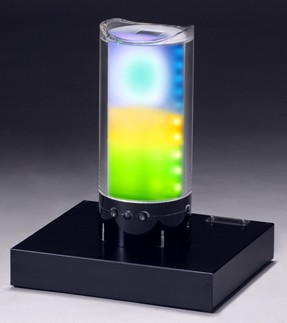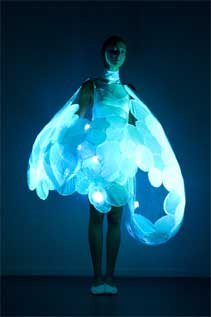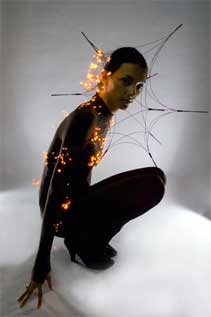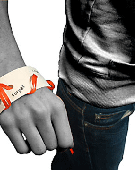Nov 25, 2009
The Razionalizer
Via Leeander
The “Rationalizer”, is a new concept device by Philips that is designed for “mirroring" your emotions.
The user wears an Emobracelet on his/her wrist which measures the arousal component of the user’s emotion through a galvanic skin response sensor. The EmoBracelet is wirelessly connected with the EmoBowl, a bowl with lighted patterns that displays user’s emotional status.
The range is a soft yellow, orange, or deep red.
When the user sees that the bowl is flashing red, it means that it might be good to take a breather and calm down before making any irrational decisions (i.e. risky investments).
See how the Razionalizer works in this concept video:
21:07 Posted in Emotional computing | Permalink | Comments (0) | Tags: emotional computing, self tracking, stress, emotion detection
Mar 16, 2008
Exmocare wins F&S Technology Innovation of the Year Award
Via Medgadget
Frost & Sullivan has awarded Exmocare, Inc. with 2008 North American Emotion Monitoring Technology Innovation of the Year Award for "developing the ExmoCare physiology and emotion monitoring platform that aids in understanding the physiological state of a person through monitoring the expression of emotion patterns. The platforms developed by the company Exmocare, Inc. are unique in that they are the first of their kind to become a first-stop solution for vital sign monitoring , emotional monitoring, and online reporting."

Press release: Exmocare Taps into $200 Billion Industry - Maker of Award-winning 24/7 Bluetooth Vital Signs Wristwatch
Product page: The Exmocare BT2...
23:36 Posted in Emotional computing | Permalink | Comments (0) | Tags: emotional computing
Sep 05, 2007
Affective diary
Via InfoAesthetics


from the project website:
The affective diary assembles sensor data, captured from the user and uploaded via their mobile phone, to form an ambiguous, abstract colourful body shape. With a range of other materials from the mobile phone, such as text and MMS messages, photographs, etc., these shapes are made available to the user. Combining these materials, the diary is designed to invite reflection and to allow the user to piece together their own stories.
18:33 Posted in Emotional computing, Information visualization | Permalink | Comments (0) | Tags: information visualization, emotional computing
Jul 26, 2007
Visual relaxation landscapes

This website shows beatiful animated landscape loops designed for visual relaxation (Flash plugin required)
19:11 Posted in Emotional computing | Permalink | Comments (0) | Tags: information visualization, emotional computing
Dec 20, 2006
ESP: Emotional Social Intelligence Prosthesis
Technology does not naturally sense nonverbal cues such as facial expressions and tone of voice, and does not easily acquire common sense knowledge about people. These "mindreading" functions also do not come naturally for some people, such as those diagnosed with autism. ESP is an affective wearable system that explores ways to augment and enhance the wearer's emotional-social intelligence. ESP's computational model of mind-reading infers in real time affective-cognitive mental states from nonverbal cues such as head and facial displays of people, and communicates these inferences to the wearer via visual, sound, and tactile feedback.
Our work leverages the advances in affect sensing and perception to (1) develop technologies that are sensitive to people's affective-cognitive states; (2) advance autism research and (3) create new technologies that enhance the social-emotional intelligence of people diagnosed with autism, as well as those who are not.
The project addresses open research challenges pertaining to whether machines can augment social interactions in a way that improves human to human communication. A longer term aim is to use the prosthesis as an assistive and therapeutic device for people with Autism Spectrum Disorder.
00:27 Posted in Emotional computing | Permalink | Comments (0) | Tags: emotional computing
Dec 15, 2006
Intelligent rooms: RoomRender
Via Pink Tentacle

SGI Japan has developed a system that can control the electronics, appliances and hardware in a room based on the spoken commands and emotions of the room’s occupants. RoomRender relies on AmiVoice voice recognition technology (developed by Advanced Media) to recognize and analyze spoken commands, enabling the room to close the blinds, turn on the heater, etc. as instructed.
Read the full story on Pink Tentacle
00:11 Posted in Pervasive computing | Permalink | Comments (0) | Tags: ambient intelligence, emotional computing, pervasive technology, persuasive technology
Nov 29, 2006
Moodjam mood visualization
Via Infoaesthetic

Moodjam is an online visualization of people's moods visualized as beautiful color strips. Users can keep a record of their moods every hour, day, and weeks and share them with friends, family or co-workers.
22:19 Posted in Emotional computing, Information visualization | Permalink | Comments (0) | Tags: information visualization, emotional computing
Nov 07, 2006
SHOJI: Symbiotic Hosting Online Jog Instrument
From Pink Tentacle
Symbiotic Hosting Online Jog Instrument (SHOJI) is a system that monitors the feelings and behavior of the people in the room and relays the mood data to remote terminals where it is displayed as full-colored LED light.

In addition to constantly measuring the room’s environmental conditions, SHOJI terminals can detect the presence and movement of people, body temperature, and the nature of the activity in the room.
Read the full post on Pink Tentacle
23:21 Posted in Emotional computing | Permalink | Comments (0) | Tags: emotional computing
Oct 01, 2006
Color of My Sound

Color of My Sound is an Internet-based application that allows to assign colors to specific sounds. The project is inspired by the phenomenon of synesthesia, the mixing of the senses.
In CMS, users choose a sound category. Then, after listening, they can choose the color to which they are most strongly drawn. finally, they can see how others voted for that particular sound.
The Color of My Sound's original prototype has recently won a Silver Summit Creative Award, and is up for a 2006 Webby, in the NetArt category.
see also music animation machine & wolfram tones.
14:30 Posted in Emotional computing | Permalink | Comments (0) | Tags: emotional computing
Sep 30, 2006
Perimeters, Boundaries, and Borders
|
Artists, architects, designers, and other practitioners are constantly fashioning new forms and challenging disciplinary boundaries as they employ techniques such as rapid prototyping and generative processes. In the exhibition Perimeters, Boundaries, and Borders, at Lancaster, UK's Citylab, organizers Fast-uk and Folly explore the range of objects, buildings, and products being conceptualized with the aid of digital technologies. Aoife Ludlow's 'Remember to Forget?' is a series of jewelry designs that envisioned accessories incorporating RFID tags that allow the wearer to record information and emotions associated with those special items that we put on daily. Tavs Jorgensen uses a data glove in his 'Motion in Form' project. After gesturing around an object, data collected by the glove is given physical shape using CNC (Computer Numerical Control) milling, creating representations of the movements in materials such as glass or ceramics. Addressing traces of a different sort is Cylcone.soc, a data mapping piece by Gavin Bailey and Tom Corby. These works and many more examples from the frontiers of art and design are on view until October 21st." Rhizome News. |
19:39 Posted in Emotional computing, Pervasive computing | Permalink | Comments (0) | Tags: ambient intelligence, emotional computing, pervasive technology, persuasive technology
Sep 21, 2006
E-garments
Via WMMNA
Philips Design has prototyped two garments that demonstrate how electronics can be incorporated into fabrics and clothes to express the emotions and personality of the wearer.
Bubelle, the "blushing dress" comprises two layers, the inner one is equipped with sensors that respond to changes in the wearer's emotions and projects them onto the outer textile. It behaves differently depending on who is wearing it. The other prototype is Frison, a body suit that reacts to being blown on by igniting a private constellation of tiny LEDs. Both measure skin signals and change light emission through biometric sensing technology.


Design Probe is an in-house far-future research program that considers what lifestyles might be like in 2020.The SKIN probe project is part of the program and challenges the notion that our lives are automatically better because they are more digital. It looks at more 'analog' phenomena like emotional sensing, exploring technologies that are 'sensitive' rather than 'intelligent'. Two outfits have been developed as part of SKIN to identify a new way of communicating with those around us by using garments as proxies to convey deep feelings that are difficult to express in words.
The Bubelle - Blush Dress comprises two layers, the inner layer of which is equipped with sensors that respond to changes in the wearer's emotions and projects them onto the outer textile. The body suit Frisson has LEDs that illuminate according to the wearer's state of excitement. Both measure skin signals and change light emission through biometric sensing technology.
Download images here
Read the full press release
10:35 Posted in Emotional computing, Wearable & mobile | Permalink | Comments (0) | Tags: emotional computing, wearable
Aug 03, 2006
empathic painting
Via New Scientist
A team of computer scientists (Maria Shugrina and Margrit Betke from Boston University, US, and John Collomosse from Bath University, UK) have created a video display system (the "Empatic Painting") that tracks the expressions of onlookers and metamorphoses to match their emotions:
"For example, if the viewer looks angry it will apply a red hue and blurring. If, on the other hand, they have a cheerful expression, it will introduce increase the brightness and colour of the image." (New Scientist )

See a video of the empathic painting (3.4MG .avi, required codec).
20:50 Posted in Cyberart, Emotional computing | Permalink | Comments (0) | Tags: emotional computing
Jul 27, 2006
The Endless Forest

12:34 Posted in Cyberart, Emotional computing | Permalink | Comments (0) | Tags: emotional computing
Jul 21, 2006
My beating heart
My Beating Heart is an haptic relaxation pillow that gently beats out a slow, steady heart-like rhythm. The $120 heart-shaped pillow uses a rumble pack-style haptic system so that you can feel the heart beat as you hold it.

From the product's website:
My Beating Heart is a soft huggable heart with a soothing heartbeat you can really feel. When hugging the heart, the tactile heartbeat reminds you of holding a pet or a loved-one. Hold the heart a moment and you'll begin to sense your own heartbeat slowly syncing with My Beating Heart's carefully designed rhythm. My Beating Heart is designed to help you relax, daydream, meditate, and nap. |
14:34 Posted in Emotional computing | Permalink | Comments (0) | Tags: emotional computing
Jul 18, 2006
Workshop on Emotion in HCI - London, UK
From Usability News
The topic of emotion in Human-Computer Interaction is of increasing interest to the HCI community. Since Rosalind Picard's fundamental publications on affective computing, research in this field has gained significant momentum.
Emotion research is largely grounded in psychology yet spans across numerous other disciplines. The challenge of such an interdisciplinary research area is developing a common vocabulary and research framework that a mature discipline requires. What is increasingly needed for advanced and serious work in this field is to place it on a rigorous footing, including developing theoretical fundamentals of HCI-related emotion research, understanding emotions' function in HCI, ethical and legal issues, and the practical implications and consequences for the HCI community.
The first workshop on emotion in HCI held in Edinburgh last year brought an interdisciplinary group of practitioners and researchers together for a lively exchange of ideas, discussion of common problems, and identification of domains to explore.
This year's workshop will build on the success of last year. Focus will be on discussion and joint work on selected topics. Participants will engage in developing further the themes from the first workshop in as wide an application spectrum as possible, such as internet applications, ambient intelligence, office work, control rooms, mobile computing, virtual reality, presence, and home applications.
You are cordially invited to become part of this interdisciplinary forum. This will be a very practical workshop with the participants working together to find new insights, views, ideas and solutions. We therefore invite contributions which will enrich the discussions by their innovative content, fundamental nature, or new perspective. We also encourage demos of products or prototypes related to the topic.
Topics addressed by the workshop are:
- How do applications currently make use of emotions and how could it be improved?
- What makes applications that support affective interactions successful?
- How do we know if affective interactions are successful, and how can we measure this success?
- What value might affective applications, affective systems, and affective interaction have?
- What requirements on sensing technologies are there in HCI?
- What technology is currently available for sensing affective states?
- How reliable is sensing technology?
- Are there reliable and replicable processes to include emotion in HCI design projects?
- What opportunities and risks are there in designing affective applications?
- What are the relationships between emotion, affect, personality, and engagement, and what do they mean for interactive systems design?
To become part of this discussion please submit an extended abstract of your ideas or demo description. Case studies describing current applications or prototypes are strongly encouraged, as well as presentations of products or prototypes that you have developed.
The abstract should be limited to about 800 words. Accepted contributions will be published on the workshop's homepage with the possibility to extend them to short papers of 4 pages. It is also planned to produce a special issue of a journal on the results of the workshop.
Please note that registration to the HCI conference is required in order to take part in the workshop (at least for the day of the workshop). Early bird registration deadline is 21st July.
Dates:
27 June - position paper deadline
11 July - notification of acceptance
21 July - early registration deadline
12 September - workshop
01:14 Posted in Emotional computing | Permalink | Comments (0) | Tags: emotional computing
Jul 08, 2006
Emotionally aware computer
According to The Herald, Cambridge professor Peter Robinson has developed a prototype of an “emotionally aware computer” that uses a camera to capture images of the user’s face, then determines facial expressions, and infers the user’s mood.
From the report:
‘Imagine a computer that could pick the right emotional moment to sell you something,” says Peter Robinson, of Cambridge University. “Imagine a future where websites and mobile phones could read our mind and react to our moods.”
It sounds like Orwellian fiction but this week, Robinson, a professor of computer technology, unveiled a prototype for just such a “mind-reading” machine. The first emotionally aware computer is on trial at the Royal Society Festival of Science in London…Once the software is perfected, Robinson believes it will revolutionise marketing. Cameras will be on computer monitors in internet cafes and behind telescreens in bars and waiting rooms. Computers will process our image and respond with adverts that connect to how we’re feeling.
20:43 Posted in Emotional computing | Permalink | Comments (0) | Tags: emotional computing
Jul 06, 2006
Next-generation gaming experiences

While players of video games have always been waiting for the next generation of technology, less fuss is made about next-generation experiences. If such experiences are already there, what are they like? What would be the 21st-century-equivalent to the experiences of Andy Capp's Tavern's customers who rushed into the bar to play Pong until the machine got jammed with coins? Ask a script writer, a political mod artist, a middleware developer, a computer game researcher, and someone who has traded off his social contacts in real life for a high-level character in a MMOG - and you will be overwhelmed by the diversity of what makes an experience worth striving for.
Department of Media at the Faculty of Art & Design of the University of Lapland and Mediapolis Innomedia project will publish a multidisciplinary book on player experiences in early 2007. The book will be a compilation of peer-reviewed articles. Respecting the department of Media's tradition of combining research with design, the book aims to piece together contemplations from researchers, designers, and those in-between, within or outside the academia.
On one hand, the extending might mean creating games that allow new kinds of experiences or are more emotional, maybe by implementing innovations regarding for example gameplay, graphics, sound or the interface. Also the players are creative. Their use of games in a way designers did not intend alters their experiences. On the other hand, the extending takes place concept-wise. In the wake of new forms of games and playing new types of players get introduced to digital games. Thus, the concept of player experience has to assimilate very different takes on how, where, when and why games are played and experienced. No matter from which viewpoint one looks at the player's experience, it seems that it poses challenges for those trying to observe or analyse it, not to mention those who are trying to understand it in order to be able to design something new.
Topics that the authors are invited to be address from the viewpoint of the players experience include, but are not limited to the following, and case-studies with an artistic or an industrial perspective are also welcomed.
Games
- Game genres and gameplay concepts, abstract games, story-based games
- Game design "trends", e.g. movie-like games with no HUDs
- Graphics and sound; audiovisual styles, cel-shading, photorealism, sound-based games
- Different player setups; one or many, local or online, one-vs-one, team-vs-team, etc.
- Avatars and other player representations
- Innovations; new gameplay concepts, platforms, input devices, interfaces, AI
- Different types of games; online multiplaying (both hc & casual), mobile and portable games, pervasive and VR games
- Content; games not only for entertaining, i.e. "seriousness" of games, in-game advertising
Players
- Different player groups and motivations; e.g. newbie, casual, hc, professional, senior, grrl, and mom gamers
- The role of "fun" in players' experiences
- Player identities
- Games as media for human relations
- Players' goals, emotions, motivations, expectations
- Consequences of playing
- Borderline activities; guild/clan webfora, mods, machinima, real-money trade of in-game assets
Methodological challenges for research and design
- Games as form of art, propaganda or education
- Design research from all viewpoints
- Philosophy of the experience
- Game-related experiences vs. other experiences
- Player's experience compared to user's/reader's/viewer's experience
- The applications of cognitive psychology, affective computing, HCI, Media Studies, etc. on understanding the players' experiences
IMPORTANT DATES
All papers will be reviewed by an independent review committee, which will provide written feedback on each paper. NB: Due to popular demand, the abstract submission deadline has been extended from the original.
June, 19. 2006 Abstract submission (was: June 5th)
June, 26. 2006 Notification of acceptance (was: June 12th)
Sept, 5. 2006 Submission of full papers
Jan, 10. 2006 Submission of final papers
00:04 Posted in Call for papers | Permalink | Comments (0) | Tags: emotional computing
Jul 05, 2006
Panasonic Emotions Testing Line
Re-blogged from Networked Performance
The Panasonic Emotions Testing Line, by "nomadic" development designer JIŘÍ ČERNICKÝ, is a conceptual SD audio-prosthesis that aims to grasp the issue of the emotional deficits in society.
The device is a substitute, personal container for the emotions of users who are not able, or do not want, to experience life through their own emotional perceptions. It looks like a Walkman-type device with headphones that does not play music inside, but rather outside, of the head. The device facilitates the user's emotional communication with the world around him. It is not designed for his/her personal use only but is equipped with a tiny amplifier.
The memory of the SD Audio Player chip card contains a great amount of data containing recordings of authentic human emotions. For instance, if the user finds himself in a situation where he has to argue with someone, yet he does not want to get into confrontation and to waste his own emotions, he locates a password on his SD Audio Player representing an appropriate emotional response, which he then applies accordingly.
The SD Audio Player can also record and thus appropriate other people's emotions: sniveling, peevishness, sobbing, moaning, crying, gradual emotional collapse, breakdown, yelling by a beaten person, the state of mind between laughter and crying, the hysterical family argument from Fellini's film Amarcord, pubescent giggling, comforting and fondling of a baby, a feeling of well-being, enthusiastic effusions, wearing somebody out, cuddling, soothing, etc. Such recordings, including those from movies, can be further edited and modified on a computer. In this way, the user can appropriate the emotions that are conveyed by celebrities and other prominent individuals.
23:35 Posted in Emotional computing | Permalink | Comments (0) | Tags: emotional computing
Jun 06, 2006
Blushing Light
Re-blogged from Mocoloco

The Blushing Light designed by Nadine Jarvis and Jayne Potter blushes in response to the emotional pitch of a mobile phone. Through conversation, the lamp is activated by the Electromagnetic field (EMF) emitted from a mobile phone and continues blushing for 5 minutes after the call has ended; prolonging the memory of the otherwise transient conversation.
19:01 Posted in Emotional computing | Permalink | Comments (0) | Tags: emotional computing
Jun 04, 2006
EMOSIVE: A mobile service for the emotionally triggered
Re-blogged from Prototype/Interaction Design Cluster
![]()
emosive (formerly e:sense) is a new service for mobile devices which allows capturing, storing and sharing of fleeting emotional experiences. Based on the Cognitive Priming
theory, as we become more immersed in digital media through our mobile devices, our personal media inventories constantly act as memory aids, “priming” us to better recollect associative, personal (episodic) memories when facing an external stimulus. Being mobile and in a dynamic environment, these recollections are moving, both emotionally and quickly away from us. Counting on the fact that near-today’s personal media inventories will be accessed from mobile devices and shared with a close collective, emosive bundles text, sound and image animation to allow capturing these fleeting emotional experiences, then sharing and reliving them with cared others. Playfully stemming from the technical, thin jargon of the mobile world (SMS, MMS), emosive proposes a new, light format of instant messages, dubbed “IFM” – Instant Feeling Messages.
21:57 Posted in Emotional computing | Permalink | Comments (0) | Tags: emotional computing










